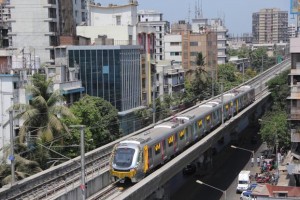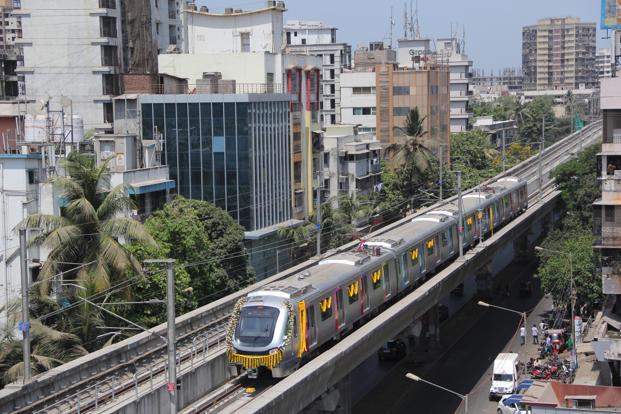 Track2Realty Exclusive: If ever you have not missed a flight out of Mumbai or got delayed to an appointment of lifetime in Mumbai due to traffic bottlenecks, you would probably not understand why India’s commercial capital has been waiting so eagerly for the metro train to roll out. But wait! There is more to just ease of traffic with the metro train in Mumbai becoming a reality.
Track2Realty Exclusive: If ever you have not missed a flight out of Mumbai or got delayed to an appointment of lifetime in Mumbai due to traffic bottlenecks, you would probably not understand why India’s commercial capital has been waiting so eagerly for the metro train to roll out. But wait! There is more to just ease of traffic with the metro train in Mumbai becoming a reality.
It also has to do a lot with the attractiveness of the business destinations, price index of the housing market, cost of commuting within the city, cost of access to basic social infrastructure and its overall economy. One metro train has multiple of backward and forward linkages to Mumbai’s society and economy, and hence this euphoria with the metro finally being rolled out.
Mumbai’s first metro railway link, which will connect the North Western Suburb of Versova-Andheri with Ghatkopar on the North Eastern peripheral, is all set to be a game changer for the subdued realty landscape of the city which was waiting for a trigger point to ignite.
The detailed analysis made on the requisite infrastructure has factually proven to positively impact real estate value in Mumbai because residential and commercial properties located close to transportation infrastructure will tend to command a premium price.
The metro will also have a positive impact on the Western Suburbs due to faster connectivity to the Eastern Suburbs especially in markets like Andheri West which will see a boost in activity. Areas like Versova, Chakala, Andheri East, Marol, Saki Naka and Ghatkopar will witness benefit from the metro connectivity and already the property value of the real estate projects have started to see a steady growth and hike in capital values. It is expected to soon take the rental value of the properties northwards as well.
In fact, a section of market watchers point out that some of the projects have already seen a price appreciation of 400 per cent over the past few years in anticipation of metro train. The residential market like Ghatkopar will also derive maximum benefit. The market is hence quite upbeat with the development. The developers also endorse the fact that surrounding region connected to the metro will definitely experience a certain boom in terms of new offerings and price hikes.
Hiral Sheth, Director-Marketing, Sheth Creators categorically says that Mumbai is the city known for its organised chaos and is yet the most preferable metropolitan city. The city consists of considerable population exposure from all parts of the country. The city dwellers are in constant endeavour to reside in areas which are well-connected and has developed infrastructure. This is the focal reason that the areas around the metro will be viewed as the Mumbai’s new age destination, categorically endowed with inter connectivity, ultra modern comforts and luxuries.
“A major beneficiary of metro rail projects is suburban areas that get connected with their cities’ business centres. When a transport project is announced, the increase in property prices happens in three phases. The first is at the time of announcement. The next is when construction begins. The final jump happens when the project is nearing completion. Moreover with this project the commercial space has been gaining prominence and well connecting to business districts like new CBD, BKC, SBD,” says Sheth.
Rates on both the commercial and residential market will increase, as the properties of Northern SBD (Secondary Business Districts), BKC (Bandra Kurla Complex) and SBD Central are the most preferred locations for investors. One specific sector which may see a boost would probably be the retail sector. Given the huge time to commute, Eastern and Western Suburbs were isolated markets. With the travel time now reduced to less than half, the target audience for high streets and malls in these regions would extend up to either of the suburban areas.
Saurabh Mehrotra, Director-Advisory Services, Knight Frank India agrees that on the residential front the introduction of metro will result in improvement of relative attractiveness of locations serviced by the metro, which in turn shall result in relative increase in residential property prices in these areas. According to him, Mumbai commercial market continues to suffer from fundamental issue of supply exceeding demand. With almost 23 per cent plus vacancy levels on an overall stock of 105 million sft, the supply overhang translates into an absorption time frame of 24 months plus.
“Introduction of metro will have little impact on correcting this fundamental issue, and hence would not impact overall market at large. However, introduction of metro has improved relative attractiveness of SBD West, particularly the Andheri Kurla Road stretch. Though introduction of metro will have little impact on overall demand revival, the improved relative attractiveness of SBD West would result in higher transaction/rental activity in the stretch. In fact, market has already started factoring in introduction of metro in the stretch. The transaction/leasing activity in SBD West in 2013 was in excess of 2 million sft, almost 35 per cent of overall Mumbai. This was far in excess of 2012, when it was recorded at approximately 1.35 million sft, 22 per cent of Mumbai market,” says Mehrotra.
Analysts believe the significant supply overhang will not permit any commercial rental appreciations in general. The easing of congestion and better connectivity on Andheri Kurla Road, would result in increased transaction volumes and reduction in vacancy levels on the stretch from a current 27 per cent to about 18 per cent by end of the year.
Divya Seth, General Manager, Valuation & Advisory Services with Colliers International agrees that major infrastructure developments centered around transportation projects have always shown to have a positive impact on real estate, not just in Mumbai but in other cities as well. As seen in the past with projects like the Jogeshwari-Vikhroli Link Road (JVLR), the Santacruz-Chembur Link Road (SCLR) and the Wadala-Chembur Monorail which had driven real estate prices, the Versova-Andheri-Ghatkopar (VAG) project will thus further enhance the already pumped up markets.
“Most micro markets in the influence area have already witnessed a significant price rise owing to the expected completion of the VAG metro project over the last few years. Typically, as seen in Delhi as well as Bangalore, an initial boost in capital prices in the immediate vicinity is seen on announcement and start of construction of the metro project. Hardly any or no price rise is seen on start of operations since the market has already factored in the impact of the proposed infrastructure,” says Seth.
With the start of the VAG metro, though the market might see a minuscule increase in capital values owing to the start of operations, the immediate impact that shall be observed would be in the rental segment. A number of office goers as well as students commuting East to West would prefer staying close to metro stations; thus enhancing demand for rental housing in the immediate vicinity.
Regions within 12 to 15 minutes of walking distance from the metro station are likely to see an increase of 10-15 per cent in the short term in rental values. Owing to enhanced demand, the capital values would also catch up in the long run.
Fact Sheet
- Investment—USD 720 million
- Size—Fleet of 16 rakes, 4 fully air-conditioned coaches
- Capacity—375 passengers
- Travel time—Reduced to 21 minutes from the current 90 minutes between Versova and Ghatkopar
- Connectivity—Improved East-West connectivity
Area to benefit
- Versova
- Chakala
- Andheri East
- Marol
- Saki Naka
- Ghatkopar





